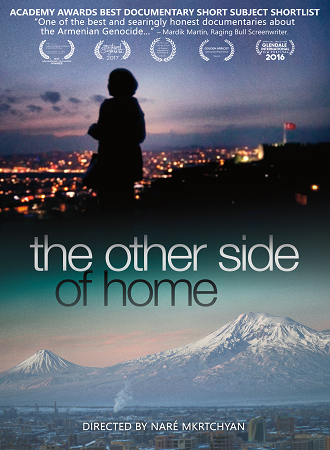
The Other Side of Home 2016
Distributed by epf media, 324 S. Beverly Drive, PMB 437, Beverly Hills, CA 90212; 310-839-1500
Produced by Naré Mkrtchyan and Robert N. Fried
Directed by Naré Mkrtchyan
Streaming, 40 mins
College - General Adult
Genocide; History; Political Science
Date Entered: 12/19/2019
Reviewed by Russell A. Hall, Reference and Instruction Librarian, Penn State ErieNaré Mkrtchyan’s short film, The Other Side of Home, is a potent narrative of how the 1915 Armenian genocide still reverberates in Turkey, Armenia, and the Armenian diaspora. The Turkish government has refused, and continues to refuse, to acknowledge the genocide and the atrocities committed against the Armenians living in what is now eastern Turkey. Mkrtchyan, an Armenian-American, tells the story through her interviews and travels with Maya, a Turkish woman who recently discovered that her great-grandmother was an Armenian survivor of the genocide. This discovery rattles Maya as it disrupts her sense of personal identity. She has great difficulty reconciling her genetic heritage with her cultural heritage. The historical aspect is only one part of this, as tensions between Turks and Armenians remains high. In Maya’s words, “I am the conflict.”
The events of the film take place in the run-up and during the 100th anniversary memorial ceremony of the genocide, held in April 2015 in Yerevan, Armenia. The movie gives a brief and graphic telling of the background and atrocities of the genocide in 1915. Maya, Mkrtchyan, and the film crew travel through Ankara and find no traces of Armenians or Armenian culture remaining. In a moving scene in this section, a shopkeeper tells Maya that he loved selling Armenian jewelry because of its beauty and great craftsmanship, but that he hasn’t had any of this jewelry in the last 20 years because there are no more Armenian artists left.
Mkrtchyan demonstrates how the genocide has rippled through the generations in Turkey and Armenia. Whether in terms of identity, culture, or views of each other, the genocide remains a part of life for these two ethnic groups. The law certainly plays a part in this. Article 301 of Turkish penal code makes it illegal to publicly criticize the Turkish government, military, or nation. The effects of this law, in concert with the cultural reticence to take blame, are shown via “man-on-the-street” interviews in Turkey, where many people don’t know (or pretend not to know) of the genocide, deny the genocide, or avoid the topic altogether. Due to a lack of an honest accounting of what happened in 1915, these wounds still fester, and as Maya states, “the less we talk about it, the hate and the darkness will grow further.”
The greatest strength of the film lies in its selection of Maya as the lens to view the ongoing effects of the genocide. Throughout the movie the viewer is repeatedly struck by Maya’s newly found dual identity as Turkish and Armenian. As much as she identifies and mourns the victims of the genocide, she still remains staunch in her Turkish nationalism, even to the point that she will not admit that Turkey was responsible for the genocide, but rather repeats the justifications used by the Turkish government through the years and heard elsewhere throughout the movie.
The Other Side of Home would be well-suited for courses in cultural studies, political science, history, and certainly other disciplines. The film provides a clear example of how historical events live on in the politics and society of today. As William Faulkner wrote, “The past is never dead. It’s not even past.”
Awards
Winner of Best Documentary Film Award for the 19th Annual ARPA International Film Festival; Best Documentary Short Subject Shortlist for the 89th Academy Awards